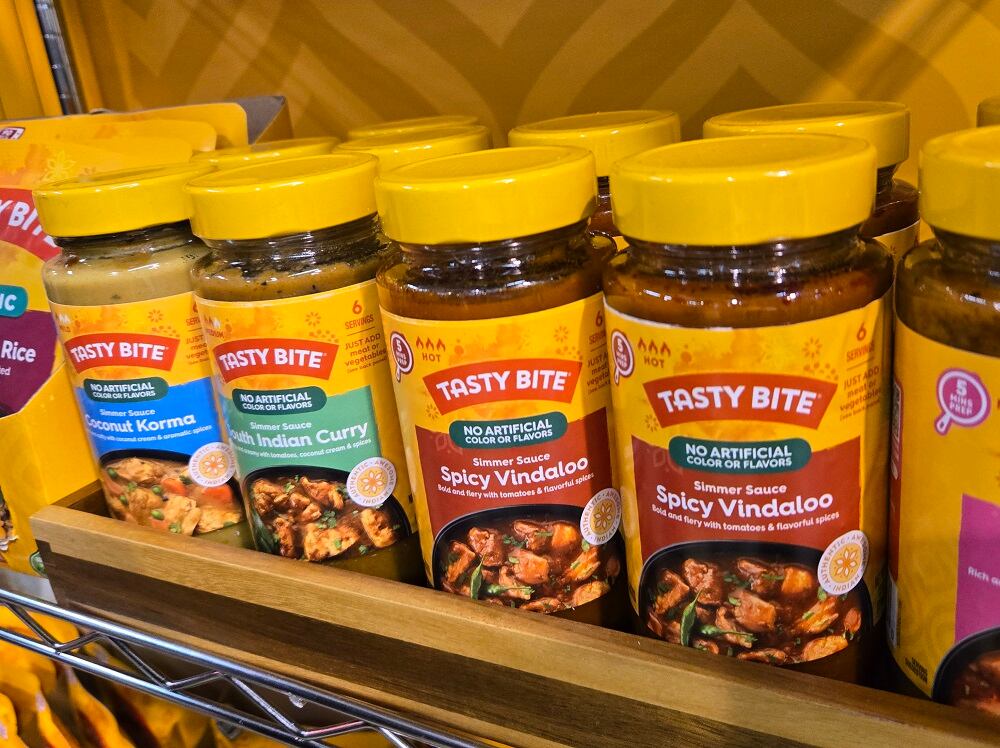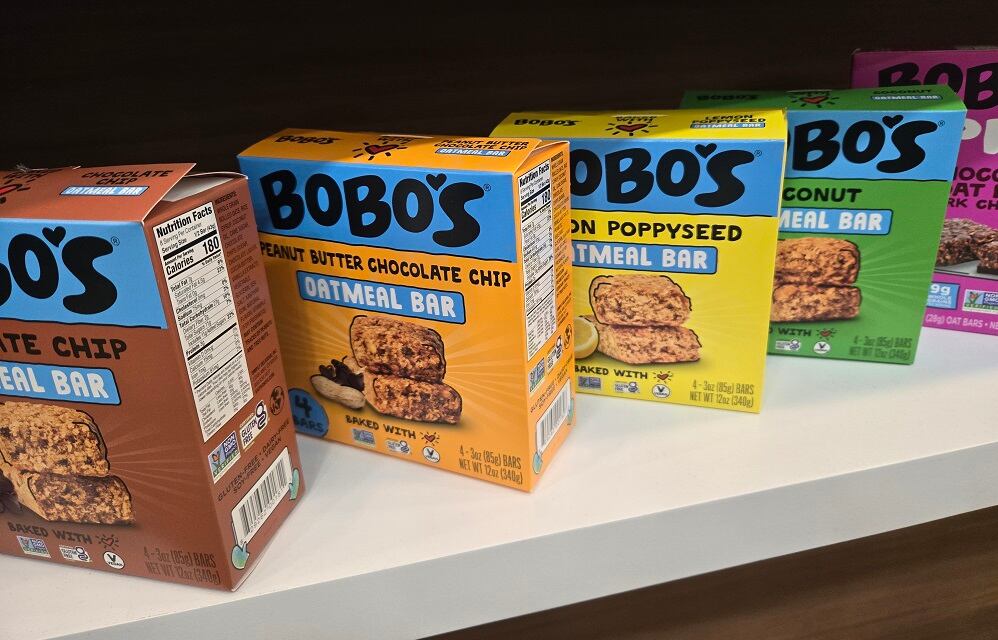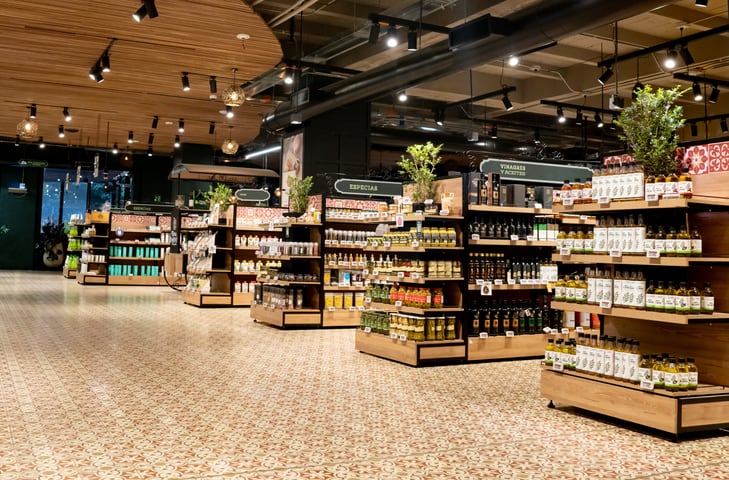A plethora of brands are unveiling new looks after years of innovation stagnation in which many companies held off debuting new products as they navigated supply chain challenges and a constricting economy in which cash-strapped consumers were less willing to try something new.
By investing in new branding, companies could reinvigorate consumer engagement without becoming bogged down in potential sourcing challenges or proving a concept by asking temporarily risk-adverse shoppers to try something new.
Among the rebrands revealed at Expo West, were new looks, streamlined messaging and repositioned products by the Indian meal company Tasty Bite and baked snacks business Bobo’s.
Both businesses lean into subtle shifts in word choice that they say will make their products more accessible and better communicate their implicit value as convenient meal solutions with clean labels. They also focus on clean label ingredients and how products check multiple dietary requirements and goals. Finally, new packaging will help the products standout on shelf.
Word play: Small changes have outsized impact
By changing oat to oatmeal and chana to chickpea, Bobo’s and Tasty Bite say they can expand the appetite appeal of their products to reach a wider audience.
“We know consumers want global flavors. We know they are interested in global flavors. We also know that they can be intimidated by global flavors. The naming conventions also might be confusing. They might not understand the names of some of the ingredients,” said Rebecca Teichman, VP of marketing at Tasty Bite.
“We are on a journey to figure out exactly the right way to communicate with US shoppers. We have started to take steps in our naming convention. So, a chickpea in India would be called chana. So, chana masala is a very common dish, but by calling it chickpea masala the US consumer more easily understands what it is. They know what chickpeas are and feel more comfortable. So, using the Americanized word for the ingredient is helpful” in making ready-to-eat, authentic Indian dishes more accessible, she said.

Likewise, Bobo’s, is changing the name of its flagship oat bars to oatmeal bars to highlight the product’s “satiation benefit,” Bobo’s CEO T.J. McIntyre said.
“This is the first time we are leaning into the caloric load of a Bobo’s bar. It is 3 ounces, and it is over 300 calories. And while other food products may be shying away from that, we are realizing that a lot of people consider 300 calories or 360 calories to be a light calorie breakfast and our oatmeal bars are convenient meal replacements,” he explained. “It is like a bowl of oatmeal to go.”
This differentiates the products from competitors that are promoted as standalone snacks or showcased as part of a meal with a smoothie, yogurt or piece of fruit.
Just as Bobo’s subtle word choice better conveys the oatmeal bars’ convenience, Tasty Bite also highlights its convenience on pack with callouts that the pouches are “ready in 90 seconds,” an attribute that Teichman said is “absolutely on trend.”
Call outs highlight clean label ingredients
Both brands also are calling out on packaging the quality of their ingredients – a move that comes as more consumers worry about food safety, nutrient density and clean labels.
For example, the new packaging for Bobo’s oatmeal bars highlights the Purity Protocol-certified oats that are gluten-free and calls out ‘vegan’ prominently.
“We have a ton of hardcore consumers of Bobo’s that have autoimmune issues, celiac disease, gluten allergy, Crohn’s disease. When they discover Bobo’s – especially with the tastiness we bring – they become very loyal. So, we include a callout on pack that the products are gluten free” and naming the specific oats adds another layer of reassurance, McIntyre said.
Likewise, he said, “vegan is probably our most important callout. It is a commitment that we came and we are adored by vegans.”

Tasty Bite’s products also are plant-based, which it communicates through tweaks to conventional name, such as its new butter chickpea and vegetables shelf stable meal, which is a plant-based riff on the popular butter chicken. It also includes a ‘made with plants’ icon on the front of pack.
Tasty Bite also highlights its “clean label” through callouts on the front that the products are free from artificial colors, flavors and preservatives and “all natural.” The ingredient decks show the products are made from “all real food,” Teichman said.
She explained the products’ clean labels are possible, even though they are shelf stable, in part because the company uses retort thermal processing, which allows the company to cook the food in kettles in a traditional manner than then process them in a high heat environment so the nutrition and macro nutrients are preserved but “anything that could cause a problem is killed.”
Want to know more about how the clean label trend is evolving?
Learn how other brands are meeting evolving consumer demand for clean label products by registering for FoodNavigator-USA’s free webinar April 16 – Clean Label 2.0: Soothing safety concerns and navigating state bans. Executives with Serenity Kids and Alta Fresh Foods will share business strategies centered on clean label, while Mintel’s director of food science and a partner with Perkins Coie share details on the evolving regulator, legislative and consumer landscape surrounding clean label expectations. Learn more and register today.
Tasty Bite further reassures consumers who may be hesitant to try its shelf stable meals and simmer sauces with easy-to-understand iconography that communicates a product’s spice level with one to three flames.
Smaller packaging better dominates shelves
As part of Bobo’s ongoing rebranding, it is rolling out a reconfigured caddy for its 12-count boxes.
Bobo’s used to have the “tallest caddy in the set,” which may sound like a way to standout on shelf but actually placed the brand at a disadvantage because fewer facings fit in its allotted space. The company lowered the height of the caddy by stacking the bars three high and four deep instead of four high and three deep. This allows it to stack two caddies on the shelf where one used to be.
The shorter box is also easier for consumers to grab with one hand, sad McIntyre.
“Our caddies were so big before you literally had to grab it with two hands, and that is an obstacle to buying a full caddy. Whereas now consumers can just grab it with one hand and throw it in the car. We know that this is going to merchandise better, and we are going to sell more caddies and that is a great way to boost velocities,” he said.
Bobo’s new look for its oatmeal bar is just the beginning. It will continue to unveil new packaging for its other products throughout the year.

